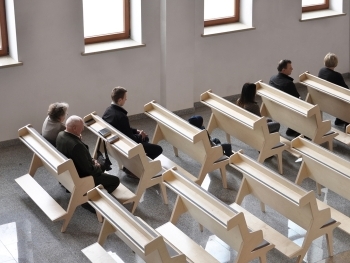Churches have long been sanctuaries for spiritual reflection, community gatherings, and religious ceremonies. The design and functionality of church interiors have evolved over centuries, reflecting changes in liturgical practices, architectural styles, and societal values. Contemporary church furniture represents the latest chapter in this evolution, merging traditional elements with modern aesthetics and innovative functionalities. This article delves into the characteristics, trends, and considerations in contemporary church furniture, offering a comprehensive overview of its role in modern worship spaces.
The Evolution of Church Furniture
The history of church furniture is as old as the Christian church itself. In early Christianity, worship was often conducted in homes or simple buildings, with minimal furniture. As Christianity became established, dedicated church buildings emerged, bringing with them a need for specific furniture to facilitate worship and community activities. Key historical developments include:
- Early Christian Period: Furniture was minimal and functional, often influenced by Roman styles. Benches and tables were common.
- Medieval Period: Gothic cathedrals introduced elaborate wooden pews, ornate altars, and richly decorated pulpits.
- Renaissance and Baroque Periods: Furniture became more elaborate, with intricate carvings and luxurious materials, reflecting the grandeur of the church.
- 19th and 20th Centuries: The Industrial Revolution and modernist movements brought simpler, more functional designs, focusing on comfort and accessibility.
Contemporary church furniture continues this tradition of evolution, balancing respect for historical forms with the demands and sensibilities of modern congregations.
Characteristics of Contemporary Church Furniture
Contemporary church furniture is defined by several key characteristics that distinguish it from historical and traditional styles:
- Minimalist Design: Emphasizing clean lines, simple forms, and uncluttered spaces, contemporary church furniture often adopts a minimalist approach. This design philosophy reflects modern architectural trends and the desire for serene, contemplative spaces.
- Multi-Functionality: Modern churches often serve as community hubs, hosting a variety of events beyond traditional worship services. Furniture is designed to be versatile and adaptable, capable of accommodating different activities such as concerts, meetings, and social gatherings.
- Comfort and Accessibility: Contemporary designs prioritize the comfort of congregants. Church Chairs and pews are ergonomically designed, with considerations for accessibility to ensure inclusivity for all members of the community, including those with disabilities.
- Sustainable Materials: There is a growing emphasis on sustainability and environmental responsibility in church furnishings. Many contemporary pieces are made from sustainably sourced wood, recycled materials, and eco-friendly finishes.
- Technology Integration: Modern worship often incorporates audiovisual elements. Contemporary church furniture includes provisions for integrating technology seamlessly, such as built-in sound systems, projection screens, and charging stations.
- Customization and Personalization: Many congregations desire furniture that reflects their unique identity and liturgical practices. Custom-made furniture allows churches to incorporate specific symbols, motifs, and colors significant to their community.
Key Pieces of Contemporary Church Furniture
Several essential pieces of furniture are central to the functionality and aesthetic of a contemporary church:
- Pews and Chairs: While traditional pews remain popular, many contemporary churches opt for individual chairs that can be rearranged to suit different needs. Modern pews and chairs often feature cushioned seating and ergonomic designs.
- Altars and Communion Tables: The altar remains a focal point in many Christian traditions. Contemporary altars are often simpler and more versatile, made from materials like wood, stone, or metal, and designed to be movable if necessary.
- Pulpits and Lecterns: These pieces are designed to facilitate reading, preaching, and speaking. Contemporary designs may include adjustable heights, integrated microphones, and sleek, modern aesthetics.
- Baptismal Fonts: Baptism is a significant rite in many Christian denominations. Contemporary baptismal fonts range from traditional stone basins to modern designs incorporating glass and metal, often with flowing water features.
- Choir and Musician Seating: With the centrality of music in worship, seating for choirs and musicians is designed for both functionality and comfort. Chairs often include provisions for holding music sheets and instruments.
- Fellowship and Community Areas: Beyond the sanctuary, contemporary church furniture includes pieces for fellowship halls, classrooms, and social spaces. These areas often feature modular furniture that can be easily reconfigured.
Trends in Contemporary Church Furniture
Several trends are shaping the design and selection of contemporary church furniture:
- Eco-Friendly Designs: Churches are increasingly mindful of their environmental impact. Furniture made from reclaimed wood, bamboo, and other sustainable materials is becoming more common.
- Hybrid Worship Spaces: The COVID-19 pandemic accelerated the adoption of hybrid worship models, blending in-person and virtual participation. Furniture design now often includes considerations for camera placement, lighting, and sound to facilitate live streaming.
- Inclusivity and Accessibility: There is a heightened focus on creating spaces that are welcoming to all. Furniture designs consider the needs of the elderly, individuals with disabilities, and families with young children.
- Artistic Expression: Contemporary church furniture often serves as a canvas for artistic expression. Custom pieces may feature local craftsmanship, community symbols, and elements that tell the story of the congregation.
- Interchangeable Spaces: Modern churches are designed to be flexible. Furniture that can be easily moved, stacked, or reconfigured allows spaces to serve multiple purposes, from worship services to community events.
- Acoustic Considerations: Good acoustics are vital in worship spaces. Furniture is designed to enhance sound quality, whether it’s through the materials used or the arrangement of seating and other elements.
Considerations for Selecting Contemporary Church Furniture
When selecting furniture for a contemporary church, several factors should be considered:
- Congregation Needs: Understanding the specific needs and preferences of the congregation is paramount. This includes considering the size, demographics, and activities of the church community.
- Liturgical Practices: The furniture should support the liturgical practices and traditions of the denomination. This might include specific requirements for altars, baptismal fonts, and seating arrangements.
- Aesthetic Harmony: Furniture should complement the architectural style and interior design of the church. A cohesive aesthetic creates a harmonious and inviting worship environment.
- Budget and Longevity: Churches must balance their budget constraints with the desire for durable, high-quality furniture. Investing in well-made pieces can save money in the long term.
- Supplier Reputation: Choosing reputable suppliers who specialize in church furniture ensures quality craftsmanship and reliable customer service. Customization options and after-sales support are also important considerations.
- Future-Proofing: Anticipating future needs and trends can help in selecting furniture that remains relevant and functional over time. This includes considering potential growth in congregation size and changes in worship practices.
Contemporary church furniture represents a dynamic fusion of tradition and modernity. It reflects the evolving needs and values of modern congregations while honoring the sacred and communal aspects of worship. By focusing on minimalist design, multi-functionality, comfort, sustainability, and technological integration, contemporary church furniture helps create spaces that are welcoming, versatile, and spiritually enriching. As churches continue to adapt to changing times, the thoughtful selection and design of furniture will play a crucial role in shaping the worship experience and fostering community connection.




